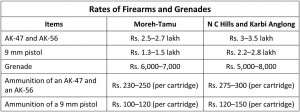The price goes higher as the consignments travels deeper into the Northeast. For instance, an AK-47 assault rifle costs between Rs. 2.5 and 2.7 lakh in Moreh–Tamu, which could go up to around Rs. 3 lakh and even higher sometimes by the time it reaches N C Hills. Among all items, the rates at which 9 mm pistols are sold have been found to fluctuate; an original Chinese-made is as expensive as Rs. 2 lakh and as less as Rs. 20,000 for assembled pieces, and this cheap variety is sold in pockets in some villages from NC Hills to Changlang, in Arunachal Pradesh.26
Alongside pistols, there are reports of assault rifles being assembled in Manipur at Moreh and Saikul. These are made of parts that come from Myanmar and local manufacturers. An AK-47 produced in these centres ranges between Rs. 1.5–1.7 lakh and would sometimes be sold off as Chinese made. Dimasa and Kuki militants who have used them said their quality was inferior as the barrel gets heated up fast and there’s problem with the magazine as well. But their demand seems to be picking up, with more and more gangs emerging in the region who have a stake in the different types of transnational crimes.
Stemming The Flow
The proliferation and misuse of small arms and grenades are vexing problems that call for a multilayered approach and coordination for prevention. India has broached the issue of proliferation many a time with Beijing, but the situation has only deteriorated, with the illegal trade indicating an increase in volume over the last few years. However, what has been encouraging for India was a statement by the Chinese representative to the UN, Li Baodong, on 20 March 2010 that his country was opposed to the illicit production and proliferation of small arms.
| Editor’s Pick |
Li, who was speaking with reference to the Central African region, pointed out that China was willing to work together with the international community towards an “early and appropriate” solution to the problem. “Each state should, on the basis of the UN Program of Action on Small Arms and in connection with its specific situation, formulate a complete set of rules and regulations on the production, possession, transfer and stockpile of small arms and ensure their effective enforcement,” he said at an open debate of the Security Council and added that countries of the region (read Central Africa) should strengthen coordination and cooperation to monitor the trade in small arms and combat illicit transactions.27
The marking of small arms is, to some extent, covered by the UN Firearms Protocol, but there is no single system for marking or tracing small arms.
Li’s statement is a heartening departure since China, along with countries like the U.S. and Russia, has always been opposed to certain measures long advocated by NGOs and think tanks across the globe that could have made a dent in the scale of the unlawful trade. Laws like legally binding international treaties on arms brokering, development of transparency mechanisms for small arms exports and imports and expansion of assistance programs to states seeking more effective implementation are being contested by countries due to the apprehension that such initiatives would encroach on their national practices and limit their future freedom of action.
In particular, NGOs have made a case for marking and tracing of weapons since it is extremely difficult to ascertain where they originated, which countries they travelled through and where they were being used. If the origin and transfer routes of weapons can be identified, it would be much easier to work out how and when they got into the hands of unintended users and identify those responsible for supplying and diverting the arms. The marking of small arms is, to some extent, covered by the UN Firearms Protocol, but there is no single system for marking or tracing small arms. A few NGOs led by the Groupe de Recherche et Convention on Marking, Registration and Tracing have developed a draft convention that addresses some of these concerns.28
The debate on proliferation has also focused on limiting the impact of weapons currently in circulation, which would perhaps hold true for the situation at Yunnan, in China, and Myanmar. When surplus weapons remain in a country, they can easily find their way to the black market. For example, a Ukrainian parliamentary commission estimated that when the country achieved independence in 1992, its military stocks were worth $89 billion.





